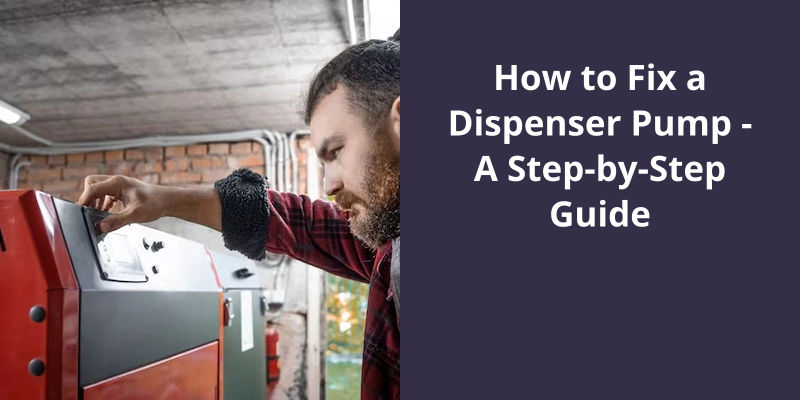To fix a dispenser pump, start by ensuring it is not locked. Many dispensers have this mechanism to avoid spillage, all you need to do is twist in the right direction to unlock it. If it’s still not working, it may be clogged. Unscrew the entire pump from the bottle and rinse with warm water. If it doesn’t seem to resolve the issue, soak the pump in warm soapy water for 10-15 minutes, this should help to unclog any residue left. Once done, reassemble the pump. Lastly, if the problem remains, it could be due to a faulty pump. In that case, your best bet is to get a replacement pump.

How Do You Fix a Lotion Pump That Won’t Pump?
Have you ever been in the frustrating situation where youve just purchased a new lotion or soap and the pump won’t work? This can be a major inconvenience, especially when youre in a hurry and need to quickly get ready for the day. Fortunately, fixing a lotion pump that won’t pump is a simple and easy task that anyone can do. The first step is to remove the pump from the bottle so that you can examine it more closely.
Once youve removed the pump from the bottle, youll want to carefully rinse off the shaft to make sure that there are no obstructions or debris that may be causing the pump to malfunction. Use warm water and a soft cloth to gently scrub away any dirt or grime that may be on the shaft, being careful not to damage the pump or it’s mechanism. Once youve thoroughly rinsed and cleaned the shaft, allow it to air dry completely before proceeding to the next step.
Once youve opened up the pump, carefully inspect the mechanism to see if anything is blocking the flow of lotion or soap. This could be a small piece of debris or a clog of some sort that needs to be removed. Use a cotton swab or a toothpick to gently dislodge any obstructions that may be preventing the pump from working properly. Be gentle and careful not to damage the mechanism in any way.
Taking care of your foaming pump is important to ensure that it lasts long and continues to dispense your soap effectively. One way to keep it clean and fresh is by flushing it with a warm water and white vinegar solution after every soap refill. However, it’s important to note that you should never soak or submerge your pump in water or any other liquid. In this article, we’ll give you a step-by-step guide on how to clean your foaming soap dispenser pump properly.
How Do You Clean a Foaming Soap Dispenser Pump?
Foaming soap dispensers are becoming increasingly popular in households and public areas because of their ease of use and sanitary nature. However, over time, the pump can become clogged and dirty with constant use. Cleaning the pump is essential to maintain it’s functionality and hygiene. One important thing to remember is to never soak or submerge your pump in water or other fluids as it will damage the mechanisms inside the pump.
In addition to cleaning the pump when needed, it’s recommended to flush your pump with a warm water and white vinegar solution with every soap refill. This will help prevent buildup and keep the pump functioning properly. Simply add a small amount of the solution into the dispenser bottle, then pump the soap dispenser several times until the solution is dispensed.
It’s important to note that the parts of the foam pump are mostly made from polypropylene (PP), which is a durable and non-degradable material. Therefore, it’s a greener alternative to aerosol dispensers that can harm the environment. Cleaning and maintaining your foaming soap pump will ensure it lasts longer and continues to provide a more eco-friendly solution to hand washing.
Whether for household or public use, keeping your dispenser clean and operating properly is essential for good hand hygiene.
Tips for Choosing the Right Foaming Soap for Your Dispenser
- Consider the type of dispenser you have. Not all foaming soaps are compatible with all dispensers.
- Read the label and choose a soap that’s gentle on the skin and effective at removing dirt and bacteria.
- Check the scent of the soap to make sure it’s something you enjoy and won’t irritate those who use it.
- If you’ve a specific skin condition, make sure to choose a soap that’s specifically designed for that condition.
- Consider the price and availability of refills for the soap you choose. Some soaps may be more expensive or difficult to find.
- Choose a soap that fits your individual preferences and needs for your home or workplace.
- Test the soap out in your dispenser before committing to a larger refill to make sure it works properly.
Source: Soap Dispenser Troubleshooting – RAIL19
Soap dispensers are an essential component of a hygienic kitchen or bathroom, but they can stop working for various reasons. One of the most common reasons is that the dispenser becomes clogged with dried or solidified soap, which prevents the soap from dispensing easily and smoothly. If you encounter this issue, don’t worry! There are some simple and effective steps you can take to unclog the dispenser and get it working like new again.
Why Do Soap Dispenser Pumps Stop Working?
After the time has elapsed, remove the pump and trigger and use a toothbrush to clean them both thoroughly. Remove all traces of soap from the dispenser mechanism. Once the dispenser is fully cleaned, you can reassemble the mechanism and test it to see if it works.
Sometimes it’s not just soap that can cause a dispenser pump to stop working. Dirt, grime, and other contaminants can clog the mechanism and prevent it from functioning properly. To address this issue, you should try cleaning the dispenser more frequently. You can also switch to a different soap formula thats less likely to clog the mechanism.
If your dispenser pump has been in use for a while, it’s possible that the mechanism may be worn or damaged. Over time, components like the spring or ball bearing can become worn and lose their effectiveness. Additionally, the pump tube itself can become damaged or worn out.
Conclusion
It’s vital to identify the root cause of the issue and employ troubleshooting techniques to address it. Whether it’s a clogged nozzle, malfunctioning motor or wiring problem, solving the problem requires skill and expertise. Regular maintenance and cleaning are also necessary to ensure the dispenser pump functions well. Timely repair and replacement of faulty parts prevent further damage to the device. Overall, it’s crucial to pay attention to the details and perform regular checks on the equipment to avoid a breakdown and extend it’s lifespan.





